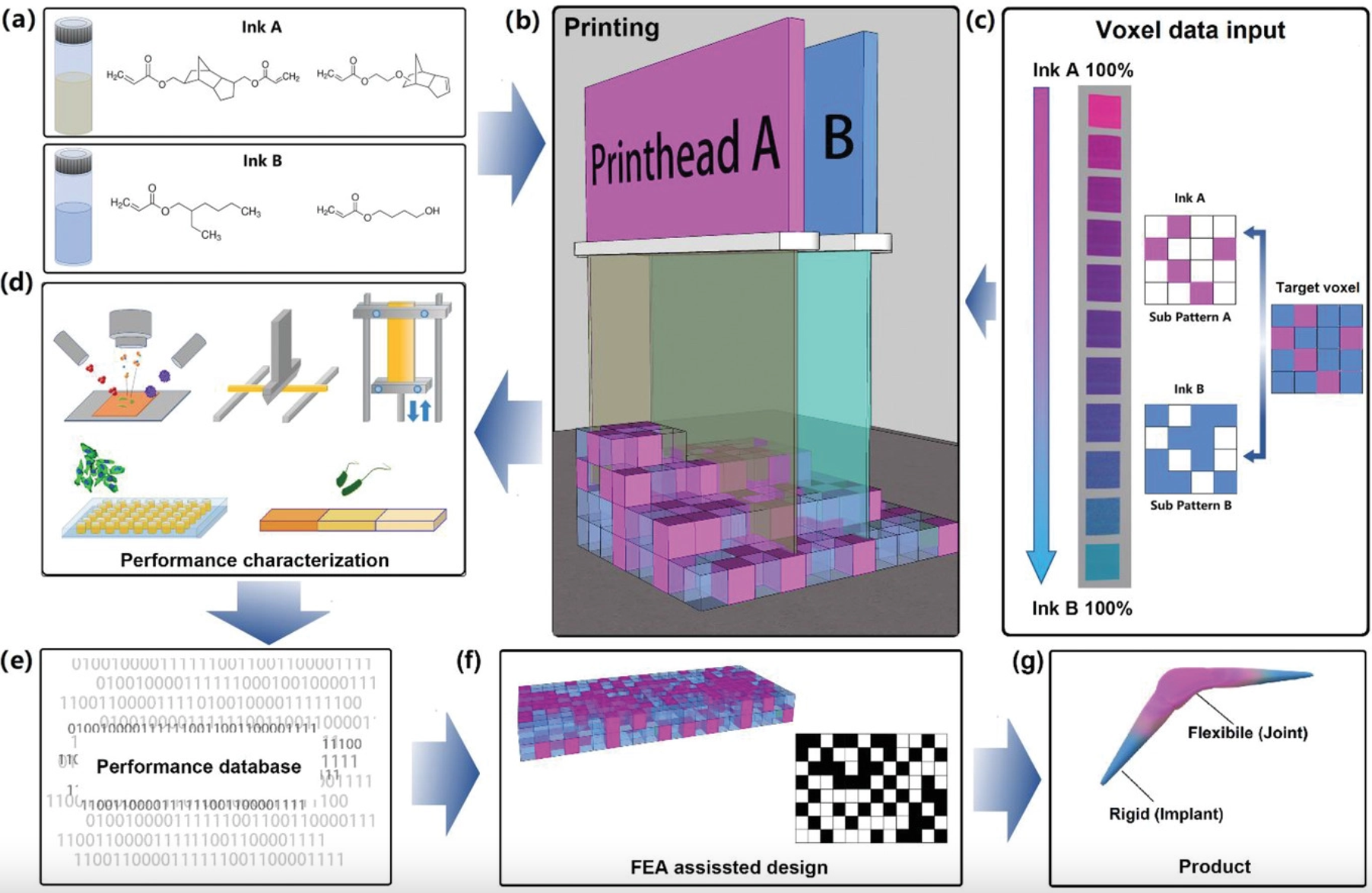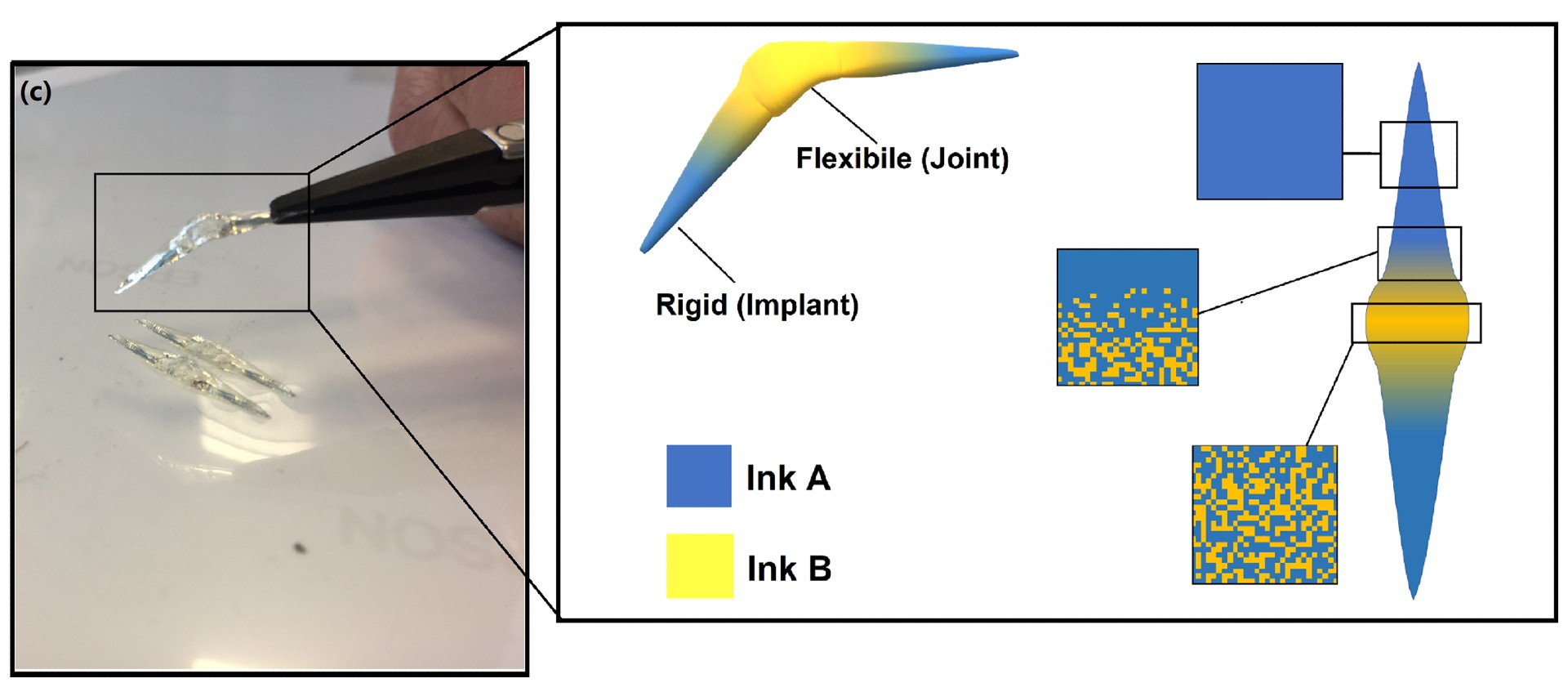New Technique Allows Researchers to Custom 3D Print Bacteria-Resistant Medical Devices
A team of engineers and health experts led by mechanics professor Ricky Wildman from the University of Nottingham, UK, found a new way to design and manufacture custom medical devices to boost performance and bacterial resistance. Using a combination of multi-material inkjet 3D printing and genetic algorithms, the researchers designed tailored composite artificial body parts and other medical devices with built-in functionality that offer better shape and durability while cutting the risk of bacterial infection at the same time. The study opens the possibility of a new manufacturing concept to produce devices with spatially distributed, customizable material functionalities in a cost-effective manner.
Medical device-associated infections, such as those on implanted prostheses, can easily become contaminated with bacteria and often result in poor clinical outcomes. This has led to major challenges in treating bacterial biofilm, which have numerous harmful effects. Biofilms are communities of bacteria isolated within a self-produced extracellular matrix that achieves up to 1,000 times greater tolerance to antibiotics, host immune system defenses. They are a major unsolved global biomedical problem that accounts for 25.6% of all healthcare-associated infections within the U.S. alone.
According to experts, there are major challenges in treating biofilms, such as difficult diagnosis, and in the clinic, biofilms can also be hard to eradicate due to their high tolerance to antibiotics, which are widely used to reduce device infections but are often accompanied by localized toxicity, and other side effects. There have been several approaches to reducing the adhesion of bacteria on medical devices, including antibacterial medication coatings in 3D printable polymers.
Inspired by the need to address device associated bacterial infections and antimicrobial resistance, the novel process proposed by the researchers and published in the journal Advanced Science proposes using a computer-aided, multi-material 3D printing technique that demonstrates it is possible to combine complex functions within one customized healthcare device to enhance patient wellbeing. According to the study’s lead author and Transitional Assistant Professor at the University of Nottingham’s Faculty of Engineering Yinfeng He, most mass-produced medical devices fail to meet their users’ unique and complex needs completely. At the same time, single-material 3D printing methods have design limitations that cannot produce a bespoke device with multiple biological or mechanical functions.
Aging populations worldwide, rising cases of chronic disease, and global health crisis are leading to a natural and increasing demand for medical devices, where 3D printing has turned into an ally thanks to its cost-effectiveness compared to conventional manufacturing techniques. 3D printed medical devices are cheaper and can be tailored and more easily replaced when parts are damaged and as children grow. Moreover, with the new technique from the University of Nottingham researchers, the healthcare field could further improve patients’ lives and ease the financial burden on growing government health budgets.

The schematic approach of the methodology followed to develop, 3D print, and characterize bespoke biofilm inhibiting devices. Image courtesy of University of Nottingham.
The study authors hope that the innovative design process can be applied to 3D print any medical device that needs customizable shapes and functions. For example, the method could be adapted to create a highly-bespoke one-piece prosthetic limb or joint to replace a lost finger or leg that can fit the patient perfectly to improve their comfort and the prosthetic’s durability. Alternatively, it could be used to print customized pills containing multiple drugs – known as polypills – optimized to release into the body in a pre-designed therapeutic sequence.
For this study, the researchers applied a computer algorithm to design and manufacture – pixel by pixel – 3D printed objects made up of two polymer materials of differing stiffness that also prevent the build-up of bacterial biofilm. They successfully achieved custom-shaped and -sized parts that offer the required flexibility and strength by optimizing the stiffness.
Through multi-material inkjet 3D printing, via a dual-head PiXDRO LP50 inkjet printer from SUSS MicroTec, they were able to engineer the ratio of different inks in each voxel to exhibit the required performance, such as modulus or transparency. They used both inkjet printable biofilm-resistant formulations and a computational design approach to direct the manufacture of multi-material devices. As part of the study, the team was able to 3D print a finger joint with the traditional functionality of artificial finger joint replacements that are also rigid enough to implant into the bone. Additionally, they customized its size and strength to meet individual patient requirements.

A bacteria-repelling artificial finger joint prosthetic with customized strength distribution made with the multi-material 3D print process. Image courtesy of the University of Nottingham.
With an added level of design control, the team performed their new style of 3D printing with multi-materials that are intrinsically bacteria-resistant and bio-functional, allowing them to be implanted and combat infection (which can occur during and after surgery) without the use of added antibiotic drugs. They also adopted a new high-resolution characterization technique from German electronics manufacturer IONTOF. The 3D orbiSIMS instrument was used to 3D-map the chemistry of the print structures and to test the bonding between them throughout the part. This identified that – at very small scales – the two materials were intermingling at their interfaces, a sign of good bonding which means a better device is less likely to break.
Today, a few antibacterial polymers are available on the market. Still, techniques to 3D print bacterial biofilm-resistant products are lacking, and prevention of bacterial biofilm formation at the surfaces of medical devices is critical. This study carried out by the University of Nottingham’s Centre for Additive Manufacturing (CfAM) and funded by the UK’s Engineering and Physical Sciences Research Council allow the design and manufacture of highly personalized devices that avoid biofilm formation and, more importantly, do not contribute to antimicrobial resistance. Before commercializing the technique, the researchers plan to broaden its potential uses by testing it on more advanced materials with extra functionalities such as controlling immune responses and promoting stem cell attachment.
Subscribe to Our Email Newsletter
Stay up-to-date on all the latest news from the 3D printing industry and receive information and offers from third party vendors.
Print Services
You May Also Like
Deployable Construction 3D Printer in the Works from Air Force and X-Hab 3D
“Impactful innovations require impactful organizational change,” Major Brian Vickers told Department of Defense (DoD) outlet DVIDS. Maj. Vickers, the Deputy Base Civil Engineer at Maryland’s Martin State Air National Guard...
US Army Considers 3D Printing for Mass UAS Production
According to Breaking Defense, the head of US Army Futures Command, General James Rainey, told an audience at the US Army’s Global Force Symposium and Exhibition (March 25-27 in Huntsville, Alabama)...
Specialty Manufacturer Plansee Pursue Refractory Metal 3D Printing via Incus
Austrian slurry stereolithography (SLA) original equipment manufacturer (OEM) Incus has sold a Hammer Evo35 3D printer to Plansee. Also Austrian, Plansee specializes in MIM, powder metallurgy, and other manufacturing processes...
3DPOD 247: LJ Holmes, Executive Director for the Center of Advanced Manufacturing and Materials at Harrisburg University
Executive Director for the Center of Advanced Manufacturing and Materials at Harrisburg University, Larry “LJ” Holmes is a pioneer in applying additive manufacturing to defense and other critical sectors. Part...


























